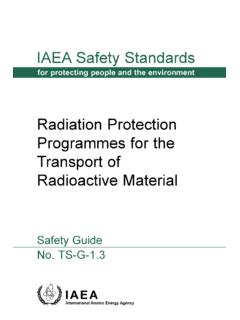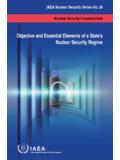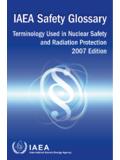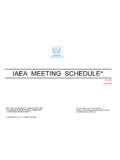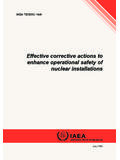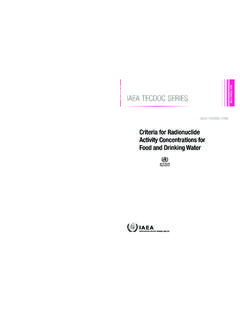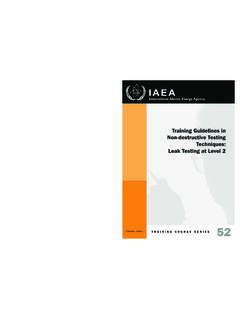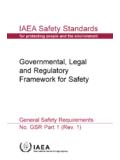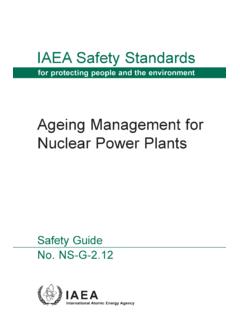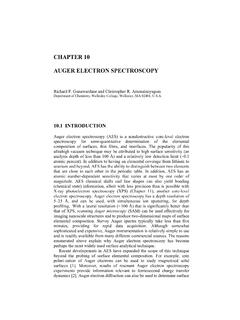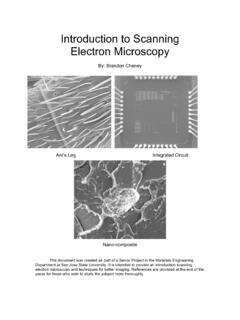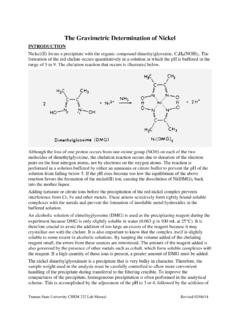Transcription of Absorbed Dose Determination in External Beam …
1 Absorbed dose Determination in External beam RadiotherapyAn International Code of Practice for DosimetryBased on Standards of Absorbed dose to WaterSponsored by the IAEA, WHO, PAHO and ESTROINTERNATIONAL ATOMIC ENERGY AGENCY, VIENNA, 2000 TTEECCHHNNIICCAALL RREEPPOORRTTSS SSEERRIIEESS 398 Absorbed dose DETERMINATIONIN EXTERNALBEAM RADIOTHERAPYAn International Code of Practice for DosimetryBased on Standards of Absorbed dose to Water IAEA, 2000 Permission to reproduce or translate the information contained in this publica-tion may be obtained by writing to the International Atomic Energy Agency,Wagramer Strasse 5, Box 100, A-1400 Vienna, by the IAEA in AustriaDecember 2000 STI/DOC/010/398 Absorbed dose DETERMINATIONIN EXTERNALBEAM RADIOTHERAPYAn International Code of Practice for DosimetryBased on Standards of Absorbed dose to WaterTECHNICAL REPORTS SERIES No.
2 398 INTERNATIONAL ATOMIC ENERGY AGENCYVIENNA, 2000 FOREWORDThe International Atomic Energy Agency published in 1987 an InternationalCode of Practice entitled Absorbed dose Determination in Photon and ElectronBeams (IAEA Technical Reports Series No. 277 (TRS-277)), recommending proce-dures to obtain the Absorbed dose in water from measurements made with an ioniza-tion chamber in External beam radiotherapy. A second edition of TRS-277 waspublished in 1997 updating the dosimetry of photon beams, mainly kilovoltageX rays. Another International Code of Practice for radiotherapy dosimetry entitled The Use of Plane-Parallel Ionization Chambers in High Energy electron and PhotonBeams (IAEA Technical Reports Series No.)
3 381 (TRS-381)) was published in 1997to further update TRS-277 and complement it with respect to the area of parallel-plateionization chambers. Both codes have proven extremely valuable for users involvedin the dosimetry of the radiation beams used in radiotherapy. In TRS-277 the calibra-tion of the ionization chambers was based on primary standards of air kerma; thisprocedure was also used in TRS-381, but the new trend of calibrating ionizationchambers directly in a water phantom in terms of Absorbed dose to water development of primary standards of Absorbed dose to water for highenergy photon and electron beams, and improvements in radiation dosimetryconcepts, offer the possibility of reducing the uncertainty in the dosimetry of radio-therapy beams.
4 The dosimetry of kilovoltage X rays, as well as that of proton andheavy ion beams, interest in which has grown considerably in recent years, can alsobe based on these standards. Thus a coherent dosimetry system based on standards ofabsorbed dose to water is possible for practically all radiotherapy beams. ManyPrimary Standard Dosimetry Laboratories (PSDLs) already provide calibrations interms of Absorbed dose to water at the radiation quality of 60Co gamma rays. Somelaboratories have extended calibrations to high energy photon and electron beams orare in the stage of developing the necessary techniques for these the recommendations in 1996 of the IAEA Standing Advisory GroupScientific Committee of the IAEA (WHO) SSDL Network, a Co-ordinated ResearchProject was undertaken during 1997 1999 with the task of producing a new interna-tional Code of Practice based on standards of Absorbed dose to water.
5 The Code isalso endorsed by the World Health Organization, the Pan American HealthOrganization and the European Society of Therapeutic Radiology and Oncology(ESTRO). The final draft was reviewed by representatives of the organizationsendorsing the Code and by a large number of Code of Practice fulfils the need for a systematic and internationallyunified approach to the calibration of ionization chambers in terms of Absorbed doseto water and to the use of these detectors in determining the Absorbed dose to waterfor the radiation beams used in radiotherapy. It provides a methodology for the deter-mination of Absorbed dose to water in the low, medium and high energy photonbeams, electron beams, proton beams and heavy ion beams used for External radia-tion therapy.
6 The officer at the IAEA responsible for this Code of Practice wasP. Andreo of the Division of Human Health. EDITORIAL NOTEA lthough great care has been taken to maintain the accuracy of information containedin this publication, neither the IAEA nor its Member States assume any responsibility forconsequences which may arise from its use of particular designations of countries or territories does not imply anyjudgement by the publisher, the IAEA, as to the legal status of such countries or territories, oftheir authorities and institutions or of the delimitation of their mention of names of specific companies or products (whether or not indicated asregistered) does not imply any intention to infringe proprietary rights, nor should it beconstrued as an endorsement or recommendation on the part of the to standards of other organizations is not to be construed as an endorsementon the part of the THIS BOOKThe structure of this Code of Practice differs from that of TRS-277 and moreclosely resembles that of TRS-381 in that the practical recommendations and data foreach radiation type have been placed in an individual section devoted to that radiationtype.
7 Each essentially forms a different Code of Practice and includes detailed proce-dures and worksheets. The Code is addressed to users provided with calibrations in terms of absorbeddose to water traceable to a Primary Standard Dosimetry Laboratory. This category ofusers is likely to become the large majority since most standard laboratories areprepared to, or are planning to, supply calibrations in terms of Absorbed dose to waterat the reference radiation qualities recommended in this Code of Practice. Users whoare not yet provided with calibrations in terms of Absorbed dose to water may stillrefer to the current air kerma based codes of practice, such as TRS-277 and TRS-381,or adopt the present document using a calibration factor in terms of Absorbed dose towater derived from an air kerma calibration as described in the text.
8 Whatever proce-dure is employed, the user is strongly advised to verify exactly what physical quantityhas been selected for the calibration of the reference dosimeter in order to apply thecorrect list of abbreviations of organizations mentioned in this Code is given inSection user is invited to critically test this Code of Practice and submitcomments to:Head, Dosimetry and Medical Radiation Physics Section,Division of Human Health,International Atomic Energy Agency,Wagramer Strasse 5, Box 100,A-1400 Vienna, AustriaE-mail: +43 1 .. Background .. Advantages of a Code of Practice based on standards of Absorbed dose to water .. uncertainty .. more robust system of primary standards .. of a simple formalism.
9 Types of radiation and range of beam qualities .. Practical use of this Code of Practice .. Expression of uncertainties .. Quantities and symbols .. Abbreviations of organizations .. The International Measurement System .. IAEA/WHO network of SSDLs .. Standards of Absorbed dose to water .. ,wBASED FORMALISM .. Formalism .. conditions .. quantities .. Correction for the radiation quality of the beam ,kQ,Qo .. modified kQ,Qofor electron beam cross-calibrations .. Relation to NKbased codes of practice .. General .. Equipment .. chambers .. assembly .. sleeve for the chamber .. of ionization chambers at the reference depth.
10 Calibration of ionization chambers .. in a 60Co beam .. in kilovoltage X rays .. at other qualities .. Reference dosimetry in the user beam .. of the Absorbed dose to water .. considerations for measurements in the user beam .. for influence quantities .. OF PRACTICE FOR 60Co GAMMA RAY BEAMS .. General .. Dosimetry equipment .. chambers .. and chamber sleeves .. beam quality specification .. Determination of Absorbed dose to water .. conditions .. of Absorbed dose under reference conditions .. dose at zmax .. Cross-calibration of field ionization chambers .. Measurements under non-reference conditions.
